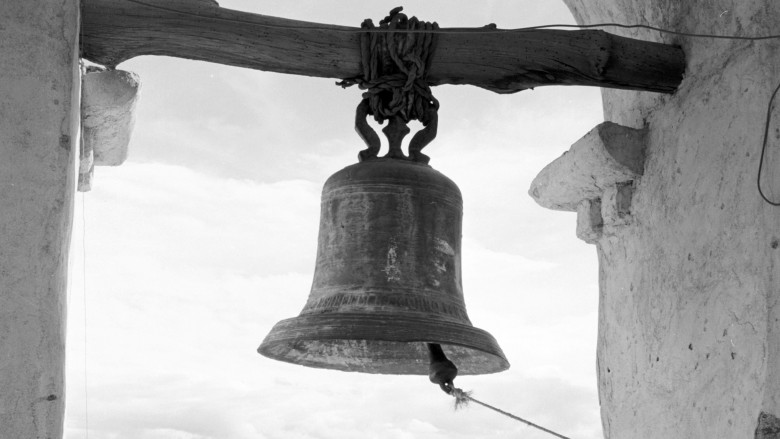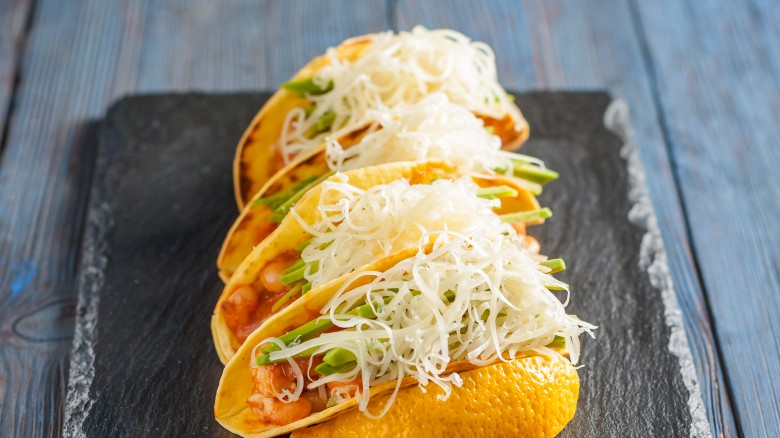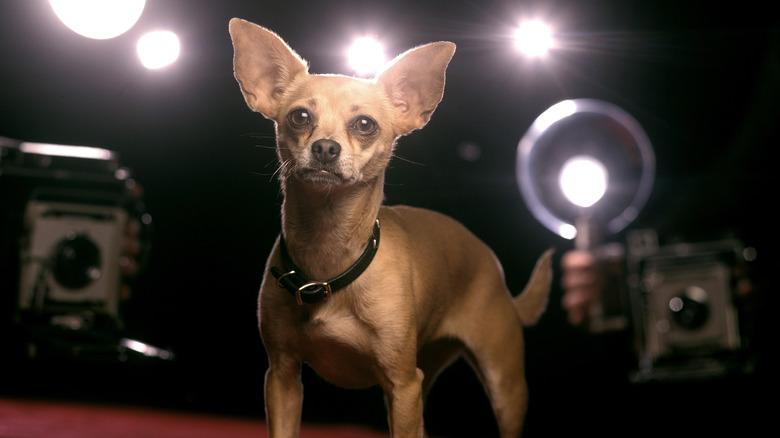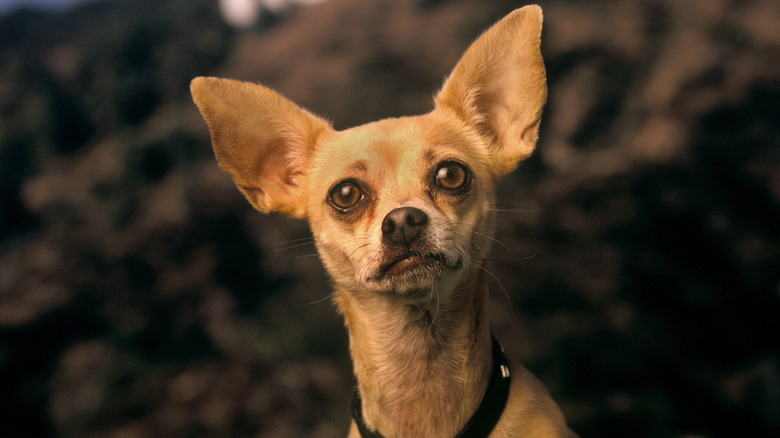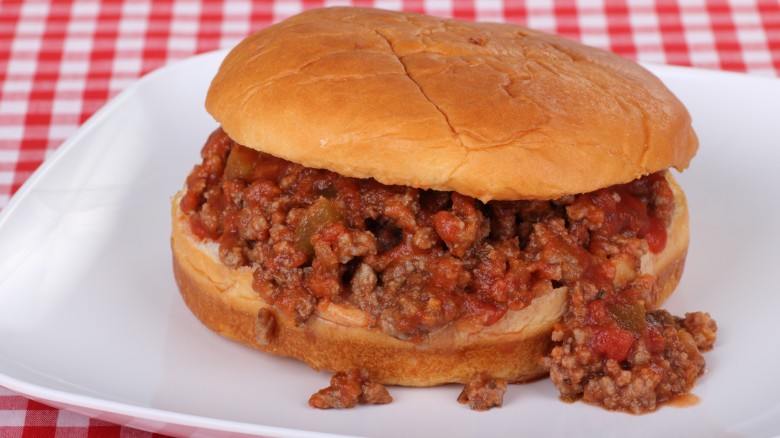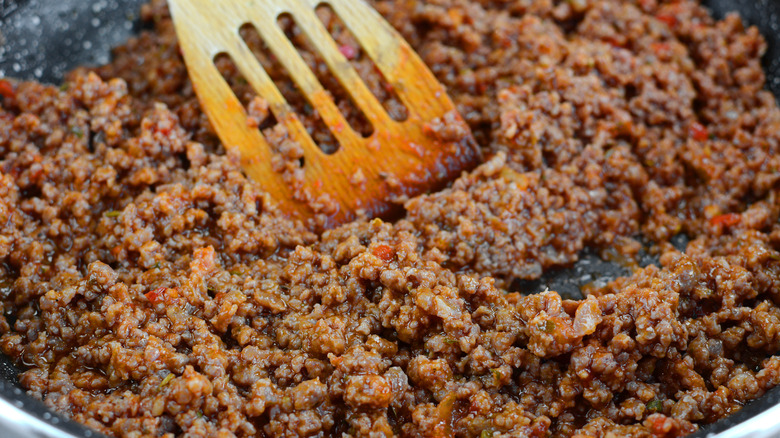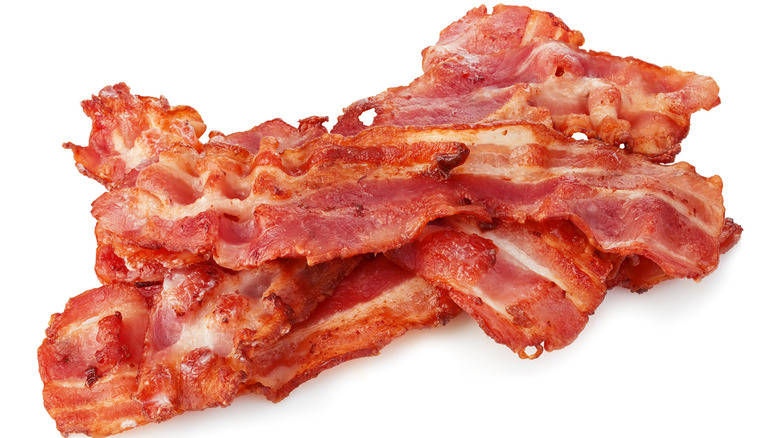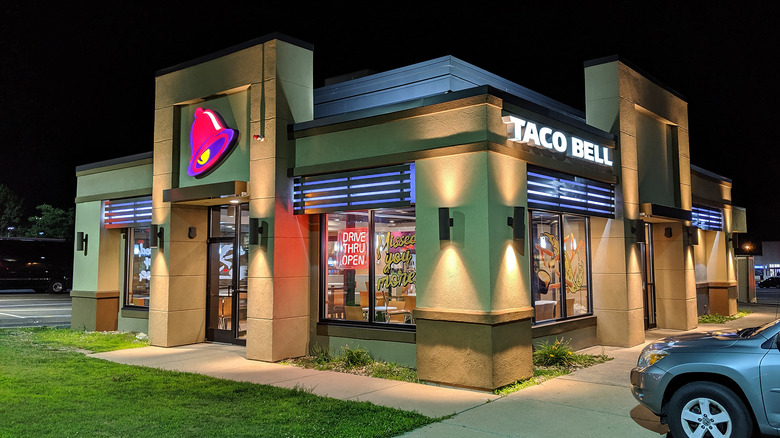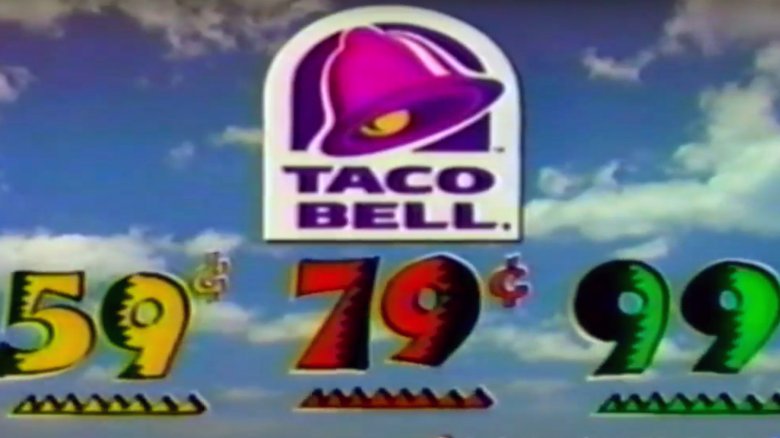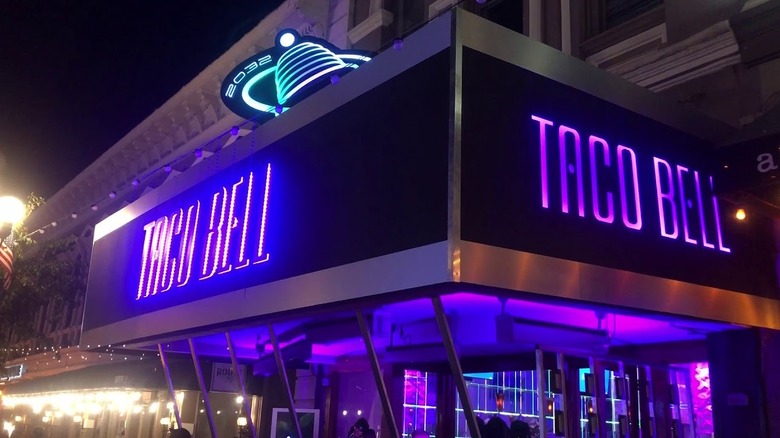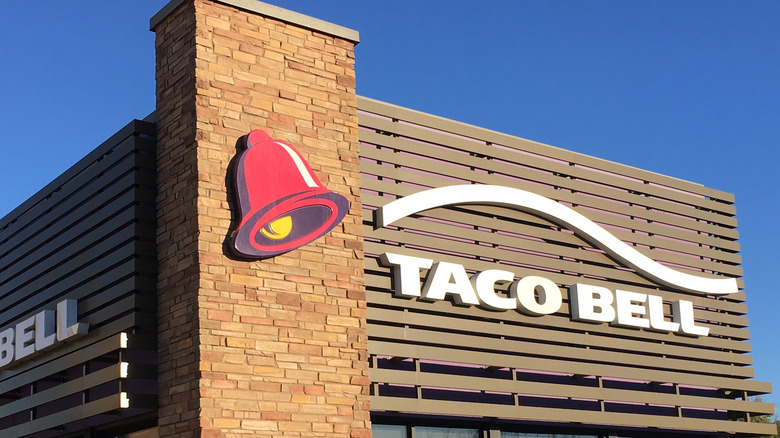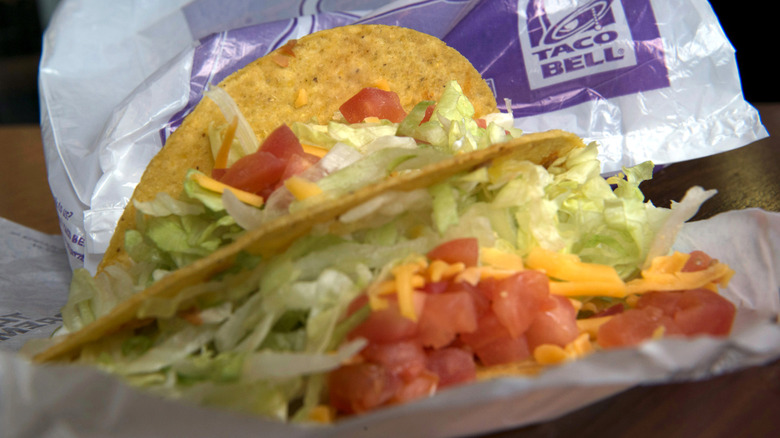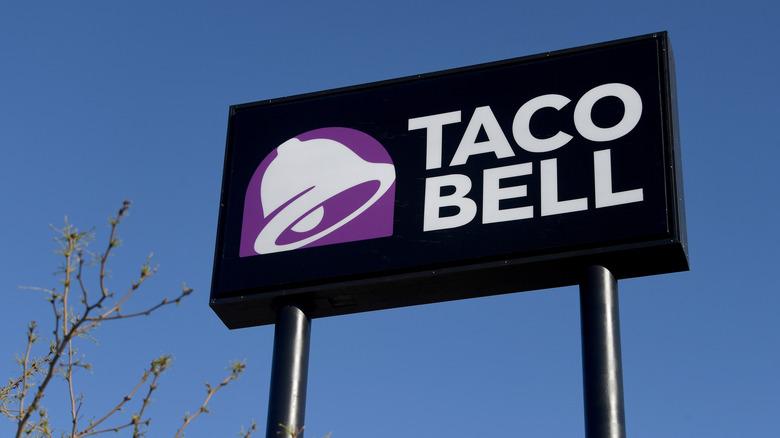Secrets Taco Bell Doesn't Want You To Know
intro
There aren't many people left in America who haven't made a run for the border. It's hard to believe that there was a time that Mexican food in the U.S. was as exotic as Ethiopian cuisine is today. Like it or not, you can thank Taco Bell for taking an "exotic" cuisine and spreading it across the drive-thrus of America. (Or at least thank Taco Bell for proliferating similar-ish ethnic foods with Spanish-sounding names.) But before you dump your life savings into a Wot Bell and try to make Ethiopian the new Mexican, you need to understand what Taco Bell is and how it got where it is today.
The bell in Taco Bell
When in the 19th century, Henry Wadsworth Longfellow penned "The Bells of San Blas," a poem about a town on the Pacific Coast of Mexico, he had never visited the town. He never did visit, but whatever. Bells are famous the world 'round. But don't worry about all that — real bells have nothing to do with Taco Bell. It's just the founder's last name. Glen Bell opened Bell's Drive-in and Taco Tia in 1954. "Tia" is Spanish for "aunt," but Bell probably didn't know that. He targeted Caucasians with his exotic international food. After selling Tia (the restaurant, not his aunt) to his partners, he opened his first Taco Bell in 1962. Only two short years later he franchised his first franchisee opened a branch and a chain was born. Just think — with a few different marriages along the way, it could have been Taco Knippelberg.
Taco Bell failed in Mexico
Just as conflating a hot dog and a veal cutlet is confusing to Germans, Mexicans didn't know what to make of Taco Bell. Taco Bell first entered into the Mexican market in the early '90s and failed spectacularly. The problem is nomenclature. Mexicans have been eating corn-based food shells for 5,000 years. Throughout the day and evening, taquerias quickly serve up tacos, which are usually corn tortillas filled with any sort of meat and slathered in salsa. Sounds nothing like Taco Bell.
Taco Bell called its tacos "tacostadas," combining the words "taco" and "tostada." To a Mexican, that's a folded tostada, and nobody wants that. Taco Bell tried the Mexican market again in the late 2000s and made it three years before closing the doors and making a run for the border.
Yo quiero un abogado
Of all the advertising slogans Taco Bell tried, nothing could possibly top a tiny dog asking for Taco Bell in Spanish. The Chihuahua created a sensation across America, and led to calls for boycotts from Latino activists. (Plus, the Spanish isn't an exact translation, but this is a food site, not a Spanish lesson.) Regardless, Taco Bell should thank its lucky stars for the guys who came up with the little dog idea. But instead, Taco Bell just stole the idea.
Joseph Shields and Thomas Rinks came up with a character called Psycho Chihuahua, a little dog that wouldn't back down from any challenge. Taco Bell executives were intrigued by the dog and approached the pair about an advertising campaign using the character. But the executives passed on using a chihuahua as the focus of the advertising campaign. Instead, they went with ... a chihuahua. Naturally, Shields and Rinks sued and were initially awarded a bit over $30 million in 2003. Of course Taco Bell appealed the verdict and it took years for a decision, but eventually a judge ruled. And Taco Bell shouldn't have appealed because the final decision was a $42 million judgment for liberating the character of the chihuahua.
Taco Bell's business faltered when it ran those ads with the dog
That long-running ad campaign featuring a talking chihuahua quipping, "Yo quiero Taco Bell," was nothing less than a phenomenon, raising visibility and the cultural cache of the Mexican fast food chain in question. That tagline became a universally known and oft-repeated catchphrase on par with "Where's the beef?" or "I'm lovin' it," and in Christmas 1998, plenty of delighted people found a plush Taco Bell chihuahua under the tree, according to the Los Angeles Times.
It wasn't without controversy. While Taco Bell ultimately paid out millions after being accused of stealing the idea, Latino advocacy groups called out the ads as more than a little bit racist, per the Los Angeles Times. In the summer of 2000, Taco Bell pulled the chihuahua-based ad campaign entirely after one final, shocking revelation: Sales at the restaurant chain actually suffered during the tenure of "Yo quiero Taco Bell." In the second quarter of 1999, for example, sales at outlets open for more than a year fell by 6% — the steepest quarterly decline ever for the company. "I realized that fundamental change at Taco Bell was necessary," David E. Novak, chairman of Taco Bell's parent corporation Tricon Restaurants (now Yum! Brands) said. Not only did executives seek to limit fallout by canceling the chihuahua ads, but they replaced CEO Peter C. Waller, too.
The Taco Bell 'hamburger'
Bacon wasn't the first time Taco Bell tried to "think outside the bun." In fact, they thought so much outside the bun that they put everything inside a bun. In the 1970s, Taco Bell introduced the Bell Beefer — basically a sloppy Joe. Unlike the bacon concoction of the 1990s, the Bell Beefer wasn't half bad. It gets a lot of love in nostalgia pages and even has a Facebook plea for its return. Taco Bell stopped carrying the Bell Beefer in the 1980s as the menu focused on more traditional Tex-Mex items. It certainly didn't help that it was the only thing on the menu that came in a bun, whereas pretty much everything else was a multi-tasker; soft and hard shells were available in multiple dishes.
Where's the beef?
Perhaps Taco Bell's darkest hours came in 2011 when a Montgomery, Alabama, law firm sued with the claim that its advertised "taco meat filling" was only 35 percent beef. Taco Bell came out swinging and issued a statement proclaiming that they start with 100 percent USDA-inspected beef. But the damage was done. Same-store sales fell 5 percent in the quarter after the news broke. There was only one way out; Taco Bell had to reveal everything in its taco meat filling.
After the lawsuit ended, Taco Bell came clean and announced its taco meat filling is 88 percent beef. If that seems a little low, it's probably because it is a bit low. Along with spices and water, Taco Bell uses oats and corn starch to fill out the beef a bit. It's not 35 percent, but having oats seems iffy. Before you freak out, nothing in the concoction is out of the ordinary. Taco Bell is just like every other fast food place.
Taco Bell put bacon on tacos
In the late 1990s, an odd food fad struck America: calling something "extreme." Everybody did it, and for some reason, "extreme" was a code word in the fast food industry for bacon. Bacon seemingly was the missing ingredient for everything and every shop was slapping bacon on something. Even Boston Market got into the act by paying a talking head to pitch their bacon stuff. Well, if you think Taco Bell sat idly by while people were putting bacon where it didn't belong, you are sorely mistaken.
Enter the Sizzlin' Bacon menu items. A bacon cheeseburger burrito, a BLT taco, and a chicken club burrito were all rolled out in 1995. If you're thinking bacon on a taco is the most unholy concoction imaginable, you're correct. People tend to wax poetic on things from a bygone era, but there are things in life you can't untaste and my first and only BLT taco — consumed in March 1996 — still gives me indigestion just thinking of it.
The fourth meal
Taco Bell finally embraced the obvious and advertised what it's known for; a late-night drive-thru meal. The Mexican after-bar standard proclaimed a new time to eat, between midnight and breakfast, and conveniently left out the part that you're probably stopping after leaving a bar. Here's the thing, there's actually some truth to a fourth meal. Eastern Europeans often consume a second breakfast, and the United Kingdom has a well-known tea time, which also features light sandwiches.
Taco Bell eventually abandoned the fourth meal campaign. Why, you ask? Well, because it became synonymous with drunken adventures at their restaurants; even by those, like Charlie Sheen, in possession of Tiger Blood. Charlie Sheen's rep laughed off the video of his drunken drive-thru visit, saying, "Where else do you go when you are hammered?" Indeed. It's one thing to just look the other way and live off the profits of staying open until 3 a.m. to feed intoxicated people, but it's another to ask people to come to Taco Bell when they're drunk.
59/79/99 made Taco Bell what it is
There was a time when Taco Bell didn't rule the international fast food world. It faced competition from Del Taco, and there still was a learning curve for learning all those foreign words. Then, suddenly, Taco Bell exploded nationwide, very unconventionally. In 1990, Taco Bell introduced a radical new menu. The majority of its menu was priced in three tiers: 59 cents, 79 cents, and 99 cents. Suddenly, every broke college student could get one item at each price point and a small soda (with free refills) for around $3.12 and still have money left over for beers. (Trust me, that was my four years of college eating.) But it wasn't just the college kid cashing in on the savings. A whole lot of people did, and Taco Bell saw 10 to 15 percent sales increases across all stores, with an overall 25 percent growth in the first year of lower pricing alone. The lower pricing worked, and Taco Bell created an empire.
Demolition Man
Product placement in movies and television programs is natural nowadays; it can be subtle as an ice cold Spook Hill Pale Ale from Red Cypress Brewery or slam you over the head like Demolition Man. In 1993, Taco Bell finagled its way into the script of the Sylvester Stallone ... ahem ... classic Demolition Man. In the futuristic film, Taco Bell won the "franchise wars" of 2030 and all restaurants became Taco Bells. Company spokesman Janis Smith explained, "The demographics of our most frequent customers (males 18-34) match their audience." Here's the thing: The Taco Bell in Demolition Man was a high-end restaurant, and we all know Taco Bell isn't that. (It is trying, though.) But in the end, no matter how it made Taco Bell look, PepsiCo, the parent company of Taco Bell, got what it wanted: the brand was out there. Of course, that's only in places where Taco Bell is known; the European cut smoothly edits in edits in Stallone saying "Pizza Hut." (You can barely tell!)
Bell's wife doesn't speak German
John Galardi needed a job. He moved from Missouri to the sunny shores of California for a new life, and after three days with no income he grew desperate. He pulled into Glen Bell's Taco Tia and asked for a job. Bell saw the kid as a go-getter and hired him on the spot. Galardi learned a lot from Bell and saw the formation and growth of Taco Bell. That inspired him to try his own chain restaurant. He decided to focus on a more traditional American fare, and what's more American than hot dogs? So he settled on an all-American name: Der Weinerschnitzel. Wait, what?
Obviously that's not very American, so they changed it by dropping the "Der" and just calling it Wienerschnitzel. They're still located all over the West. But you know what they don't have? Wienerschnitzel. As you may know, wienerschnitzel is a German dish in which breaded veal is lightly pan-fried. So why don't Wienerschnitzel restaurants carry any wienerschnitzel? Galardi didn't name the place. He remained close with Glen Bell, and it was Bell's wife who came up with the name. She scanned a cookbook, came across a wienerschnitzel recipe, and suggested the name. "It was a stupid name," Galardi admitted in 2012. Needless to say, if the restaurant ever opens a location in Germany it'll have a lot of confused customers.
Did Taco Bell steal its entire concept?
Taco Bell may have been the first Mexican-style fast food operation to take hold in the United States, but it certainly didn't offer anything objectively new. While its Mexican-inspired cuisine is centuries old, founder Glen Bell lifted many of the chain's original concepts directly from another restaurant.
Taco Bell's signature menu item, culinary jumping off point, and major contribution to the food landscape is the hard-shell taco, filled with seasoned ground beef, shredded cheddar cheese, and lettuce. According to BBC Travel, Lucia Rodriguez ate mashed potato-filled hard-shell tacos (as opposed to soft tortilla based ones) with her family in Jalisco, Mexico, and when she and Salvador Rodriguez immigrated to San Bernardino, California, and opened an eatery called the Mitla Cafe, they put hard tacos on the menu, using an array of ingredients readily available: beef, cheese, lettuce, and tomatoes. The restaurant proved popular, particularly its tacos, and in 1948, a man named Glen Bell opened a hot dog stand across the street, which eventually added hamburgers to the menu, and then tacos, after which his business evolved into Taco Bell.
As of 2021, Mitla Cafe was still in business, and the Rodriguezes' daughter-in-law Irene Montaño still worked there, as she had decades earlier when she encountered Bell. "I remember him," she said, "used to come in late at night, ask lots of questions about how we made tacos, and then leave."
Food safety has repeatedly been an issue for Taco Bell
A fast food restaurant empire is a huge undertaking, and providing thousands of outlets with all the ingredients it needs makes for a complicated supply chain involving dozens of independent vendors for which the final client has little to no oversight. The occasional result: a food safety issue, where impurities or dangerous germs can make their unwelcome way to the menu, detected after it's too late. Taco Bell has been the source of several such scandals, which could damage its reputation and hurt business.
Per CNN, a 2006 outbreak of E.coli, a potentially deadly food-borne pathogen, made 71 Taco Bell customers very sick, with experts believing tainted lettuce was the culprit. Five years later, according to the Los Angeles Times, 18 Taco Bell locations were connected to a salmonella outbreak that seriously sickened 68 people, primarily in Texas and Oklahoma.
In 2019, according to CBS News, three different Taco Bell customers reported finding tiny pieces of metal in their food, prompting Taco Bell to launch a massive recall-and-disposal drive, removing 2.3 million pounds of seasoned ground beef (used in tacos and burritos) from hundreds of outlets in 21 states in the eastern U.S. Before the recall was announced, Taco Bell was oddly cagey, according to Business Insider, not allowing customers to order beef-based selections without publicly providing a reason.

